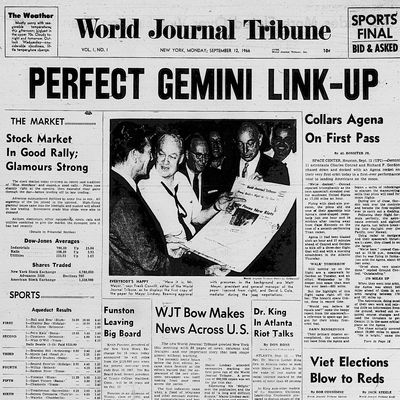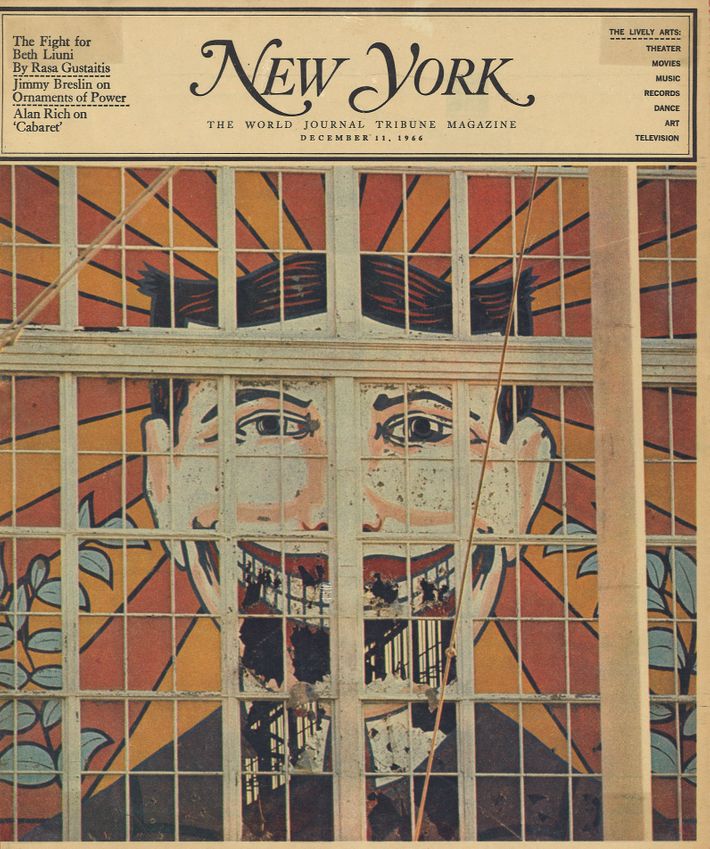
We’re living through the collapse of the newspaper business — or at least the print newspaper business; web media seem to be doing just fine — and not for the first time. The last great shuddering implosion was five decades ago, and the numbers tell the story. In the summer of 1962, there were seven daily papers in New York, three in the morning and four in the afternoon. By the summer of 1966, there were three, all of which publish today: the Times, the Daily News, and the Post. The shakeout was a huge hit to the local news economy, not to mention to the thousands of people put out of work.
But after there were three, there were — very briefly — four. Fifty years ago today, a new and pretty good afternoon newspaper hit the stands, called the World Journal Tribune. It was a final attempt to keep a second high-quality broadsheet going in New York, a Frankenstein’s monster stitched together from the corpses of three collapsed dailies. And its DNA lingers in a news product more familiar to you than you may realize.
A few things drove the collapse. TV news, of course, was on the rise,
and had been chipping away with increasing vigor at print readership and advertising for a
decade. A 114-day newspaper strike in the winter of 1963 was also a big
part of it — four months of expenses without income, at papers that were already showing signs of frailty, was brutal on them as businesses, and gave local TV news just the opportunity it needed to gain momentum. There was the hard fact that New York was losing population, not gaining it. And, weirdly, traffic congestion was part of the problem. The four afternoon dailies were meant for consumption on the subway or at home before dinner. Printed in multiple editions updated throughout the day, mostly to catch the scores of baseball and football games that were then still mostly played in the afternoon, they had to be on newsstands by about 4 p.m. If the delivery trucks were delayed an hour in traffic, the papers would go unsold — and that was beginning to happen ever more often.
So the deathwatches began. The Daily Mirror closed in October 1963. The World-Telegram & The Sun, a right-wing broadsheet that had been merged into existence in 1950 by the Scripps-Howard publishing company, was hanging on for dear life. The same went for the populist Journal-American, owned by Hearst and described by its alumnus Jimmy Breslin as “a paper where, believe me, ya couldn’t even believe the weather report.” More prominent, and editorially more respected, was the Herald Tribune, the only paper in town that challenged the New York Times on its own turf. The Trib was a broadsheet with international ambitions, a center-right alternative to the center-left Times with swingier writing, better art direction, and (at least until it had been sold to the Whitney family in 1958) weak business management. It mattered, but it, too, lost a lot of money.
Well, when you have three failing businesses, the solution is to merge them, right? And, implausibly, that’s what happened. The plan was to form a joint operation and relaunch in April 1966. The Trib and the Tele and the Journal-American put out their final editions on April 23 and 24, and planned to publish a merged paper the next day. Except that the Newspaper Guild couldn’t work out terms with the owners, and held everything up again. The launch was delayed for another few months.
It finally hit newsstands 50 years ago this afternoon. The World Journal Tribune, it was called, although that unwieldy name quickly gave way to a nickname, the Widget, from its “WJT” acronym. The newsroom was at Barclay and West streets, in a building — it’s still there — that had been the World-Telegram’s headquarters. Herbert Kamm, its executive editor, said the Widget was aiming to be “sophisticated but not snobbish,” and that it was aimed at urbanites and would not chase suburban readers. The first day’s edition ran to 80 pages, in 930,000 copies, and sold out almost instantly.
It wasn’t bad, either. Stan Fischler, who’d worked for the Journal-American until it shut down, was semi-complimentary in The Village Voice, calling it “well developed around the top yet editorially weak-kneed and somewhat blemished in the area of typeface. It bears a strong resemblance — mostly for the better — to at least one of its parents, the World Telegram and Sun, while betraying features of the others.” He also noted that nobody could keep the name straight: “At least one reporter mistakenly wrote ‘World Journal Telegram’ under his byline three different times.” Breslin was probably its highest-profile columnist, among several. The Sunday magazine was a reincarnation of the Herald Tribune’s highly regarded weekend supplement, where the reporting staff included Tom Wolfe. Dick Schaap’s first column, in Volume 1, No. 1, was titled “What Happened to Fun City?”
Inadvertently, that headline could’ve described the Widget’s short, uneasy life. Circulation settled in at 700,000 copies most days, but the paper never got out of the red. The three owners didn’t see eye to eye with one other, the unions continued to lean in, and the whole enterprise ran at a loss of $700,000 a month. Eight months later, it was gone, its last edition published on the afternoon of May 5, 1967. (Tellingly, the newsroom was full of microphones and cameras that day: Broadcasters, not newspapers, were giving everyone the news that the Widget had folded.) Mayor John Lindsay made some noise about finding a new investor to prop it up. The Times’ Arthur Ochs Sulzberger said he’d take a look at it. So did the owners of El Diario/La Prensa, who were thinking about an English-language spinoff. Nothing worked out.
Well, almost nothing. The Widget’s Sunday magazine, reincarnated from the Herald Tribune’s, had been run by an ambitious, sharp-witted editor named Clay Felker, and it was called New York. After the Widget collapsed, he and a few investors bought the nameplate, hired a few (very few) of its staff members, and relaunched the whole thing as a glossy weekly whose digital edition you are reading right now. Since 1968, there have been a couple of attempts to launch new dailies — a briefly and unsuccessfully revived Mirror, the successful-for-a-while New York Newsday, the promising but unprofitable New York Sun — but none has survived, and it seems probable that either the News or the Post will be gone in the foreseeable future. Ever so faintly and improbably, the Widget still lives.































